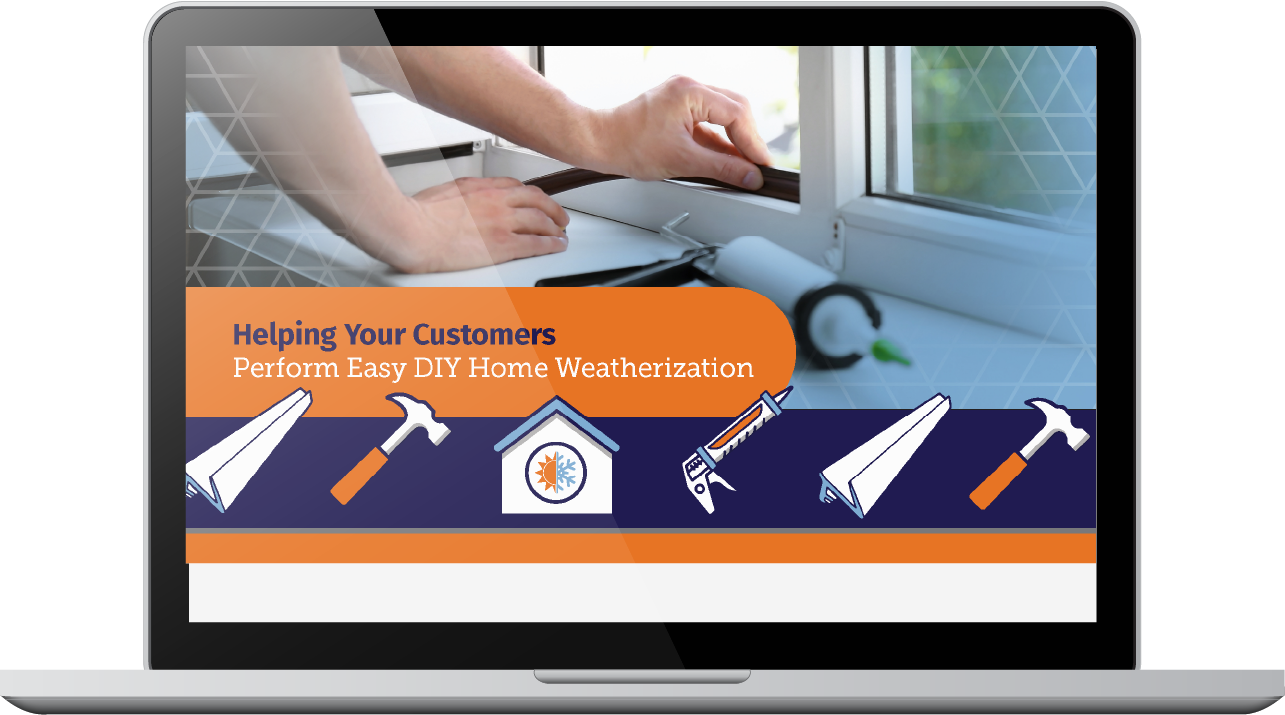Fall has arrived, and it’s bringing cooler temperatures with it. And while not every area of the country may experience the frigid temperatures common in the Northeast, regardless of where you or your customers live, you can benefit from weatherization tricks and treats.
No matter how well-built your customers’ homes are, chances are they still have some drafty areas. Maybe they can feel cold air when standing near the kitchen window. Or maybe they get an urge to put on a sweater when standing near the wall between their living room and garage. It can be tempting for homeowners to just ignore these trouble spots. But they’ll be happier and realize benefits if they don’t—and you can help them along the way.
A well-insulated and well-sealed home can improve air quality, control humidity and moisture, minimize outside noise, repel insect and rodent invaders, and help prevent destructive ice dams on the roof. Plus, a home that’s weatherized will improve energy efficiency and save money. ENERGY STAR® estimates that sealing the air gaps in a home and adding extra insulation where needed can cut monthly heating and cooling costs by 15 percent. That amounts to significant savings for a simple fix.
While some weatherization projects can be costly and require the help of a professional, even the most-timid DIYer can work some Halloween magic with weatherstripping and a caulk gun. Stop high energy use from haunting your customers with these frightfully easy DIY tips:
Insulation
Warm air naturally flows toward cooler areas. And all homes have hidden cracks and crevices that encourage outside air to leak in, and inside air to leak out. This not only reduces energy efficiency, but it can also increase the pollutants that flow inside a home and circulate.
 For those customers who don’t need whole-home insulation, or who want to complete some quick and easy fixes themselves, suggest they start by using spray-foam insulation in targeted areas, like windows and doors. Additional projects include insulating water pipes with Polyethylene Hot-Water Pipe Insulation, insulating water-heater tanks with insulating wraps, and eliminating drafts from outlets by installing Switch- and Outlet-Sealing Gaskets. You can offer and promote these products on your utility’s marketplace along with a quick “how to” video or written instruction guide for added customer satisfaction and engagement.
For those customers who don’t need whole-home insulation, or who want to complete some quick and easy fixes themselves, suggest they start by using spray-foam insulation in targeted areas, like windows and doors. Additional projects include insulating water pipes with Polyethylene Hot-Water Pipe Insulation, insulating water-heater tanks with insulating wraps, and eliminating drafts from outlets by installing Switch- and Outlet-Sealing Gaskets. You can offer and promote these products on your utility’s marketplace along with a quick “how to” video or written instruction guide for added customer satisfaction and engagement.
Air Sealing
Windows and doors are primary sources of leaking heat. Stop those leaks in their tracks with the following steps:
- Fill outdoor gaps between the frames of doors and windows and siding with caulks or other sealants, like
- Use glazing putty to secure loose windowpanes into the frame.
- Install weatherstripping, door sweeps and shoes to prevent heat loss in gaps between doors and frames.
- In areas of the country with very cold or wet weather conditions, seal windows airtight and eliminate condensation, cold drafts and heat loss with window insulation kits.
Make sure you educate your customers on where to find the products to complete these projects and provide easy-to-understand instructions for getting them done.
Quick Fixes
One of the easiest fixes in a home is to change air filters every month during the colder months. Changing the air filter has numerous benefits that most people don’t consider. First and foremost, regularly changing the air filter extends the life of the HVAC unit and lowers energy costs. According to the Department of Energy, consistently changing the air filter can save a household 5 to 15 percent annually. With the average family spending $2,200 a year on their energy bill, savings can add up. Changing the air filter monthly also helps maintain healthy air quality, which is especially important for families with asthma or allergies.
 While smart thermostats may not fall under weatherization, they are a quick route to energy savings for anyone that hasn’t installed one. Smart thermostats help save energy by learning behaviors, and helping users set schedules that save the most energy. Most smart thermostats have a way of knowing when users are home or away either through third-party integrations or geofencing capabilities and use this information to lower energy use when it’s not needed. They also learn more about a user’s preferences as they keep using the device, saving more energy over time.
While smart thermostats may not fall under weatherization, they are a quick route to energy savings for anyone that hasn’t installed one. Smart thermostats help save energy by learning behaviors, and helping users set schedules that save the most energy. Most smart thermostats have a way of knowing when users are home or away either through third-party integrations or geofencing capabilities and use this information to lower energy use when it’s not needed. They also learn more about a user’s preferences as they keep using the device, saving more energy over time.
For your customers, weatherizing their home can be one of the easiest and most inexpensive ways to increase their comfort, help the environment, lower energy bills, and improve their home’s air quality. Even if they’ve never wielded a caulk gun or have no idea what spray foam insulation looks like, you can guide them through the DIY process of weatherization.
For a more in-depth look at the DIY home weatherization process, download our e-book, Helping Your Customers Perform Easy DIY Home Weatherization.

